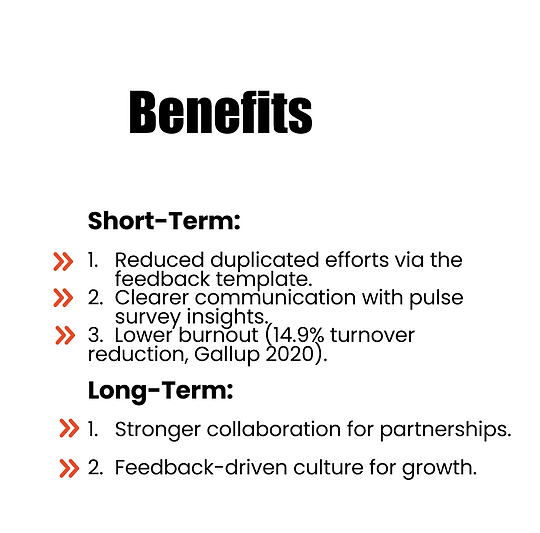Projects
I design projects that bridge product, strategy, and communication to create practical solutions for digital health and beyond.
Cross-Functional Communication Toolkit
Project Designer & Lead
For my Capstone project, I developed a Cross-Functional Communication Kit tailored for digital health startups, aimed at reducing miscommunication and strengthening collaboration across business, clinical, and product teams. The toolkit integrates pulse surveys, structured feedback loops, and leadership communication practices to create psychological safety, align priorities, and support sustainable team performance in fast-paced environments.

Start Up Problem Statement
The toolkit was born out of a real challenge I experienced during a major bio convention. While demonstrating our app’s performance, the clinical data did not display as expected, and the business development team struggled to explain the discrepancy to potential partners. This near-crisis (after months of preparation) highlighted how misaligned communication and siloed workflows can jeopardize both credibility and opportunities.
Upon closer review, the problem traced back to departments working under leadership’s assumptions and tight deadlines, creating bottlenecks, inefficiencies, and communication breakdowns. This experience made it clear that digital health startups need a structured yet adaptable way to improve communication, align teams, and focus everyone on shared goals. My Capstone project, the Cross-Functional Communication Kit, was designed to address exactly that need.


Light Weight Toolkit
The Lightweight Communication Toolkit was designed to make a meaningful impact on team alignment without disrupting daily operations. It introduces two simple yet powerful tools:
-
One-Question Pulse Survey – A quick check-in that asks employees: “How clear are communication expectations?” rated on a 1–5 scale. This offers teams a fast way to track clarity and identify potential misalignment.
-
Simplified Meeting Feedback Template – A short 2–3 minute form that gathers input on meeting takeaways, redundancy, and overall clarity.
Both tools are intentionally easy to adopt, providing instant feedback that leaders and teams can act on right away. While lightweight, the toolkit is also flexible, with the option to scale into a deeper 6-step feedback loop when organizations are ready to integrate more comprehensive communication practices.
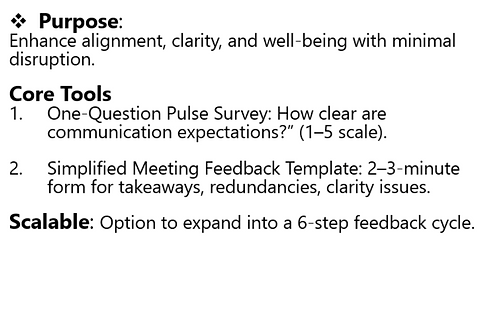

Meeting & Feedback Template
A central component of the toolkit is the 6-Step Feedback Cycle, a structured yet lightweight process that teams can adopt to continuously improve communication:
-
Train team leads – Leaders are trained in empathy and Radical Candor so they can provide feedback constructively while maintaining trust.
-
Introduce lightweight tools – Teams begin with simple, low-barrier tools such as a one-question pulse survey and a feedback template.
-
Evaluate survey results – Responses are analyzed to identify communication gaps, bottlenecks, or redundancies.
-
Cross-functional feedback meetings – Teams meet to discuss findings and align on problem areas.
-
Action planning – Practical steps are created to address issues raised in the surveys.
-
Re-survey after four weeks – Teams repeat the short survey to measure progress and close the loop.
This cycle provides a modular and repeatable approach: leaders set the tone, surveys capture quick insights, and structured meetings ensure that feedback leads to concrete improvements. The cycle emphasizes both accountability and psychological safety, making it adaptable to fast-moving startup environments.
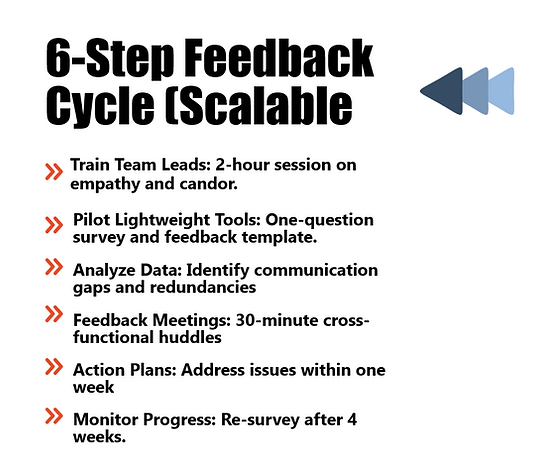
Implementation Plan
Implementation of the toolkit begins with team leads, since they serve as role models and are central to communication across functions. Training at this level will focus on empathy and Radical Candor, equipping leaders to deliver constructive feedback while building and maintaining trust.
The next step is to pilot the lightweight tools, beginning with a one-question survey and feedback template. Survey results will be analyzed to identify communication gaps and redundancies.
Based on these findings, cross-functional feedback sessions will be conducted to openly discuss issues and align on solutions. From these discussions, action plans will be developed to address the identified challenges.
Finally, a follow-up survey after four weeks will measure progress, ensuring that improvements are sustained and that the feedback cycle remains ongoing.
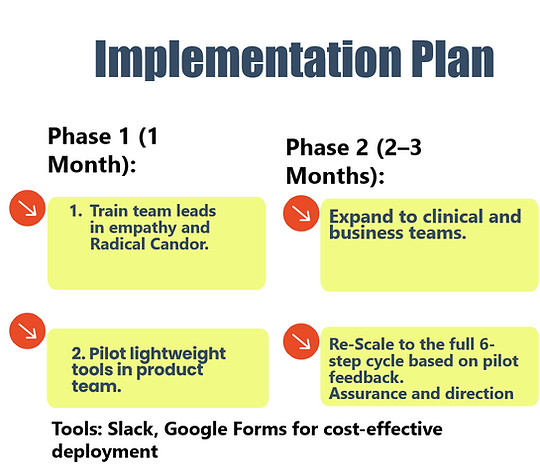

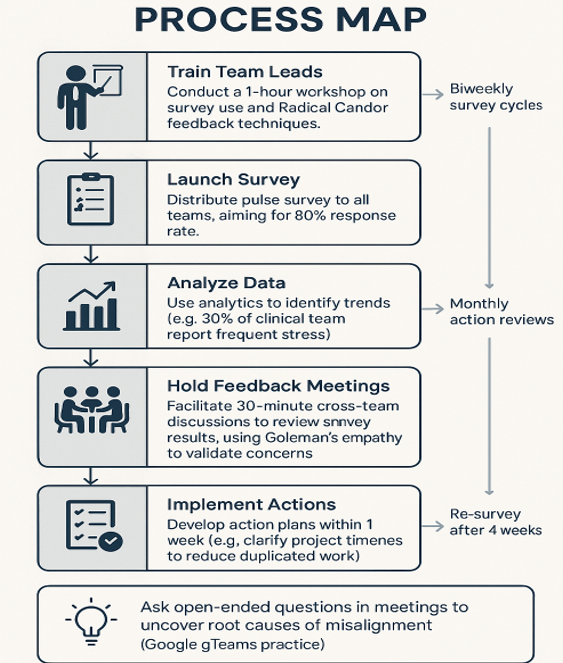
Impact
The adoption of this toolkit offers both short-term and long-term benefits:
-
Short-Term Benefits
-
Reduces duplicated efforts by clarifying team roles and responsibilities.
-
Improves communication clarity through the use of pulse surveys.
-
Decreases burnout by ensuring issues are identified and addressed early.
-
Research by Gallup (2020) shows that enhanced communication and reduced burnout can lower turnover by 14.9%, underscoring the tangible value of this approach.
-
-
Long-Term Benefits
-
Builds stronger collaboration and trust across cross-functional teams.
-
Supports sustainable partnership development by embedding feedback-driven practices.
-
Cultivates a culture of growth, where continuous feedback drives learning and alignment.
-
Positions the organization for long-term success through greater teamwork, agility, and shared accountability.
-
